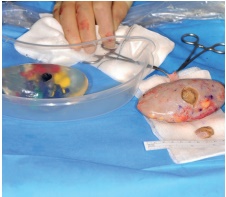A 3D printed replica kidney manufactured by UK-based firm, axial3D has helped surgeons perform a complex and life-saving kidney transplant on Pauline Fenton – a young mother in Belfast, United Kingdom.
Fenton’s Story
Twenty-two year old Pauline Fenton, a UK-resident and a mother was diagnosed with a kidney disease, which was at the last stage. Fenton, 22 was wholly reliant on dialysis. She received a kidney donor who was none other than her 45-year-old father Mr. William. However, as fate may have it, William was diagnosed with a cyst known as Bosniak 2F renal cyst on his kidney which he was about to donate to his daughter.

Above: Posterior side of William’s left kidney with black mass showing tumour/Image Credit axial3D
William’s potentially cancerous cyst on the donor kidney made the already difficult procedure more complex as surgeons now had to first treat the kidney before proceeding towards the transplant.
How 3D printing simplified the complex procedure?
To make the complex procedure simple, a team of surgeons at Belfast City Hospital turned to 3D printing technology. The surgeons decided to make a 3D printed replica model of William’s donor kidney. This kidney was printed exactly based on the William’s data obtained through his computed tomography (CT) scans.
Printed exactly with William’s anatomical data, the 3D printed kidney replica allowed the surgeons to know the exact size and placement of the tumour and cyst. This largely helped the surgical team to plan and prepare for the surgery, remove the cyst from William’s kidney and transplant it to Fenton. It has been the first time that Bosniak 2F renal cyst has been removed from a donor’s kidney without requiring the use of revision surgery.
What surgeons said about 3D printing technology?
The complexity of the surgery can be best explained in the words of Tim Brown, Consultant Transplant Surgeon. Brown said in an official statement released by axial3D, “In this case, our donor’s kidney was the best possible option for his daughter’s life saving transplant, so we had to ensure precise and complete excision of the cyst to retrieve maximum healthy tissue for transplantation”.

Above: Consultant Transplant Surgeon Tim Brown/Image Credit: axial3D
Speaking about how the 3D printed replica helped in the surgery, Brown explained, “We planned and rehearsed the surgery precisely, using an exact replica of the donor kidney containing the size and position of cyst, so my team knew the precise procedure required in the operating theatre. This level of insight is just not achievable with standard pre-operative imaging. This father’s gift of life to his daughter proves the benefit of living organ donation but in this case, I’m certain 3D printing also played a part in helping us to give this young mother an improved quality of life and the opportunity to see her child grow up.”

Above: (L) 3D Model of Kidney used as a visual aid to completely remove lesion. (R) Kidney with removed lesion/Image Credit: axial3D
As surgeons, we are highly trained and skilled at what we do, but by having a 3D print of the patient’s anatomy in my hand, I get an extra level of understanding that just isn’t possible with 2D or 3D images on screen. In this case, I could plan the surgery in detail, considering the best approach, as well as the potential problems, before stepping into the operating theatre.
“We work with surgeons with the core aim to improve patient outcomes; reduce operating times and ultimately help advance surgical education and planning for the future. We’re proud that our technology can have profound positive impacts on improving the quality and length of patients’ lives and we’re delighted that our work provided significant benefit for this family”, said Daniel Crawford, Founder of Belfast-based axial3D who produced the model for Mr. Brown.



